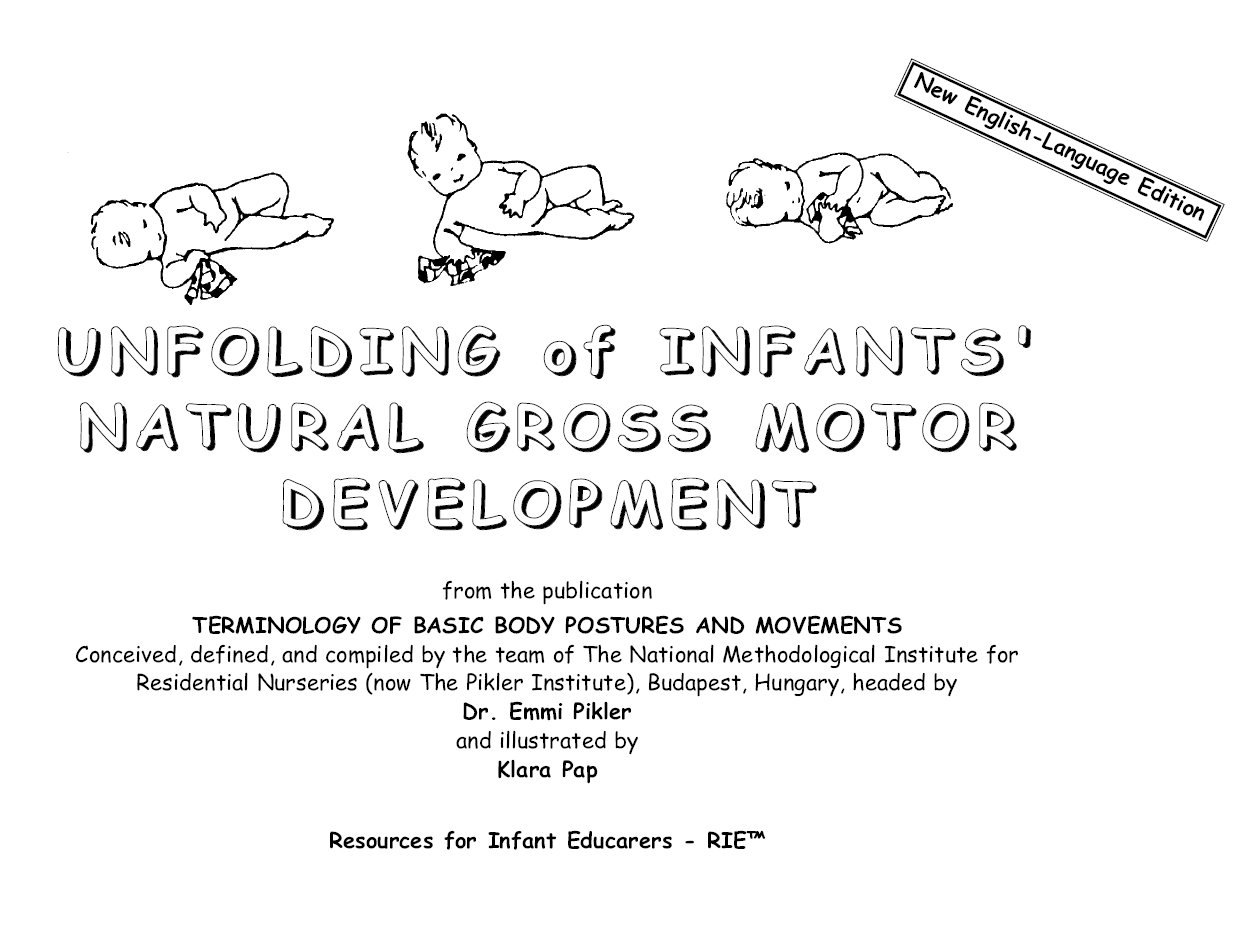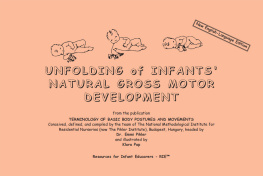Dr. Emmi Pikler - Unfolding of Infants’ Natural Gross Motor Development
Here you can read online Dr. Emmi Pikler - Unfolding of Infants’ Natural Gross Motor Development full text of the book (entire story) in english for free. Download pdf and epub, get meaning, cover and reviews about this ebook. publisher: Resources for Infant Educarers, genre: Children. Description of the work, (preface) as well as reviews are available. Best literature library LitArk.com created for fans of good reading and offers a wide selection of genres:
Romance novel
Science fiction
Adventure
Detective
Science
History
Home and family
Prose
Art
Politics
Computer
Non-fiction
Religion
Business
Children
Humor
Choose a favorite category and find really read worthwhile books. Enjoy immersion in the world of imagination, feel the emotions of the characters or learn something new for yourself, make an fascinating discovery.
- Book:Unfolding of Infants’ Natural Gross Motor Development
- Author:
- Publisher:Resources for Infant Educarers
- Genre:
- Rating:5 / 5
- Favourites:Add to favourites
- Your mark:
- 100
- 1
- 2
- 3
- 4
- 5
Unfolding of Infants’ Natural Gross Motor Development: summary, description and annotation
We offer to read an annotation, description, summary or preface (depends on what the author of the book "Unfolding of Infants’ Natural Gross Motor Development" wrote himself). If you haven't found the necessary information about the book — write in the comments, we will try to find it.
Unfolding of Infants’ Natural Gross Motor Development — read online for free the complete book (whole text) full work
Below is the text of the book, divided by pages. System saving the place of the last page read, allows you to conveniently read the book "Unfolding of Infants’ Natural Gross Motor Development" online for free, without having to search again every time where you left off. Put a bookmark, and you can go to the page where you finished reading at any time.
Font size:
Interval:
Bookmark:

UNFOLDING OF INFANTS NATURAL GROSS MOTOR DEVELOPMENT
From the publication TERMINOLOGY OF BASIC BODY POSTURES AND MOVEMENTS Conceived, defined, and compiled by the team of The National Methodological Institute for Residential Nurseries
(now The Pikler Institute and also called Loczy), Budapest, Hungary, headed by Dr. Emmi Pikler and illustrated by Klara Pap
(Original translation into English by Mrs. M. Vrosy-Tth, reviewed by Mrs. Magdolna Gerber)
Published by

Resources for Infant Educarers (RIE)
1550 Murray Circle, Los Angeles, CA 90026 (323) 663-5330, FAX (323) 663-5586
Web site:
Copyright 2006 by Resources for Infant Educarers (RIE)
This new English-language edition published for RIE by Ruth R. Money
Designed and edited by Ruth Money and Joan Weaver
Captions and descriptions expanded by Carol Pinto and Kei Kaneshiro
Reviewed by Anna Tardos and Ute Strub
All rights reserved. No part of this book may be reproducd or transmitted in any form without the prior written permssion of the publisher, except for the inclusion of brief quotations in a review.
Printed in the United States of America on acid-free paper
Cataloging-in-Publication Data will be found at the end of this book
ISBN 1-892560-07-0
WHAT THEY ARE SAYING ABOUT UNFOLDING
This is a truly eye-opening book!
A whole different view of infants movement development.
Its also about how infants gain confidence in their own abilities when allowed to do what they can do instead of being urged to do what they cant.
This book gives you something to think about!
Janet Gonzalez-Mena, Co-Author, Infants, Toddlers, and Caregivers, Fairfield, California
The engaging illustrations provide comprehensible insights regarding the complexities of infant gross motor development.
This book will be a welcome addition to the library of both practitioner and parent.
Donna M. Ferriero, M.D., Professor, Departments of Neurology and Pediatrics, Chief and Director of Child Neurology, School of Medicine, UC San Francisco
This is an amazing and unique resource.
Based on meticulous observation of infants natural gross motor development, the descriptions and explanations of infants developing ability to move are clear and insightful. The true-to-life illustrations convey the competence of infants to move freely and naturally.
Peter Mangione, Co-Director, Center for Child and Family Studies, WestEd, Sausalito
This is powerful information. It offers incredible insight on infant and toddler gross motor development for even the experienced teacher.
The detailed illustrations complement the text. I highly recommend it.
Ani Shabazian, Ph.D., UCLA Department of Psychology,
Executive Director, Megan E. Daly Infant Development Program, Los Angeles
I love this book and can see many uses for it in a Physical Therapy or Feldenkrais curriculum for both children and adults.
Beth Rubenstein, Physical Therapist, M.S., P.T., and Feldenkrais Teacher, G.C.F.T., Los Angeles
The exquisite drawings in this book are such a gifta reminder of how an infants intrinsic spontaneous movements contribute to his mastery, competence, and joy.
Thank you for reminding me of what really matters in my work with students.
Donis Eichorn, R.N., Ph.D., Associate Clinical Professor, Department of Pediatrics, School of Medicine, UC Davis Medical School, Sacramento
I think it would be very useful as a resource guide that pediatricians could go to when there is a question about motor development.
I know I would like very much to have that information available.
Mary Beth Steinfeld, M.D., Assistant Clinical Professor, Developmental-Behavioral Pediatrics, UC Davis Department of Pediatrics, M.I.N.D. Institute, Sacramento
RIE is grateful to Dr. Piklers daughter, Anna Tardos, current director of The Pikler Institute, and to Klara Pap, the illustrator, for permission to use the 1978 book as the basis for this English edition. We are also grateful to Magda Gerber, who brought Dr. Piklers philosophy of respect to the United States in 1957 and who has enriched our lives with her own contributions.
We offer this book from Dr. Piklers original studies to inspire those of all disciplines who work with infantsphysicians, nurses, physical therapists and other movement specialists, psychologists and others who administer diagnostic tests, infant care providers, as well as parentsto be able to foster better gross motor development in infants by clarifying through these descriptions and illustrations the basic process of how babies are naturally able to move well without assistance. Dr. Piklers approach focuses on natural healthy development, rather than pathology, and values the quality of the movement rather than the age at which the movement is acquired.
CONTENTS
FOREWORD
This book offers fresh insights into the possibilities of infant gross motor development. In the days before video, Klara Pap was employed as an artist to draw the children at Loczy. Her drawings are over forty years old, but they are as alive today on paper as they were in the moment when she first captured these infants moving naturally in the context of their everyday lives. I hope that readers will take time and not project onto these drawings what they already have learned about infant development, but to look at them through the eyes of Emmi Pikler.
Dr. Pikler wrote in 1969, In the course of our research, I discoveredin contrast to my expectationsthat, with the exception of a few details, there is almost no mention of motor development based on the infants own initiative and independent experimentation. I believe, therefore, that my experiences and observations are, in many respects, new for this special branch of knowledge (Pikler 1969).
Emmi Piklers studies were new in her own time, and they remain relevant in ours. They required detailed, sensitive observation of the infants spontaneous, self-initiated independent activity. Thoughtful organization of the physical and human environment in which the children were raised supported their joy and satisfaction in their free movement.
The technology used in current research is recording the complexities of infant development and the interactions between the brain, movement, and the environment. Researchers are increasingly interested in putting infants in laboratory situations to test and document their surprising learning abilities. Maybe, looking at the infants in this book will give us a perspective from which to formulate other kinds of research, informed by the naturalistic studies at Loczy. The drawings and terminology in this book could be a bridge to a common understanding for all who work with infants.
What Emmi Pikler learned took many years and many individual children. She looked at each infant as a whole human being, fully competent for his or her stage of development, not as a subject of research.
As a movement educator, I believe that this book will allow people with different levels of experience, education, exposure, and interest to see how capable infants are and to appreciate how the natural progression of infant development is richer and more varied than has been documented before. Of special interest is the attention paid to transitional postures. Knowledge of what is possible in infant motor development is important for deciding when and howor whetherto intervene; it challenges assumptions about assisting infants.
Next pageFont size:
Interval:
Bookmark:
Similar books «Unfolding of Infants’ Natural Gross Motor Development»
Look at similar books to Unfolding of Infants’ Natural Gross Motor Development. We have selected literature similar in name and meaning in the hope of providing readers with more options to find new, interesting, not yet read works.
Discussion, reviews of the book Unfolding of Infants’ Natural Gross Motor Development and just readers' own opinions. Leave your comments, write what you think about the work, its meaning or the main characters. Specify what exactly you liked and what you didn't like, and why you think so.










